What is E-A-T and why is it important?
E-A-T (Expertise, Authority and Trust) are three important components Google takes into account when ranking sites for sensitive topics, such as finance. And forms a part of Google’s Search Quality Raters Guidelines (SQRGs).
To clarify, E-A-T isn’t a direct SEO ranking factor, but is crucial for organisations operating in “Your Money or Your Life” (YMYL) industries (more on this later).
Google uses proxy metrics to measure E-A-T, with links and mentions from authoritative sites the main ingredients, with a sprinkle of other unknown signals.
However, you can create an experience on your site that is indicative of E-A-T.
As a result, you’ll be in a stronger position to gain links and mentions from authoritative sources.
Importantly, your site and brand will be more credible and trustworthy to your potential customers – a win-win all round!
What is YMYL and why is it important?
“Your Money or Your Life” (YMYL) are industries that can impact on your current or future well being. Think about financial, health and current events related topics.
Google places extra stringent measures to ensure these topics return the most authoritative and trustworthy sites.
From Google’s own guidance on YMYL in their Search Quality Rater Guidelines (SQRGs):
“We have very high Page Quality rating standards for YMYL pages because low quality YMYL pages could potentially negatively impact a person’s happiness, health, financial stability or safety”
Source: section 2.3 of SQRGs
Google also writes:
“where our algorithms detect that a user’s query relates to a “YMYL” topic, we will give more weight in our ranking systems to factors like our understanding of the authoritativeness, expertise, or trustworthiness of the pages we present in response.”
Source: How Google Fights Disinformation; page 14
To bring this to life, let’s say you search for ‘how to get a mortgage’.
We can see below the paid ads that Google ranks authoritative and trustworthy brands, such as Barclays, due to the sensitive nature of the topic:
Are you fulfilling the objective of the page?
As part of the SQRG, quality raters are asked to evaluate whether a page has a beneficial purpose.
“As long as the page is created to help users, we will not consider any particular page purpose or type to be higher quality than another.”
Source: section 2.2 of SQRGs, What is the Purpose of a Webpage?
The key here is to ensure that your pages are fulfilling their purpose and ultimately being helpful to your users.
This is going to be relative to the page in question.
For example, let’s say I’m looking to get a business card for my small startup business. I want to see the options out there and come to an informed decision on what product is right for me.
Essentially, I’m looking for a product landing page, so I want this product landing page to fulfil certain objectives such as:
- Quickly (if not immediately) understand what the page is about
- As it’s a financial product, I want to be reassured that they’re credible
- Clearly outlining the product features and benefits
- Product price plans
I search ‘business account card’ and land on a Monzo page:
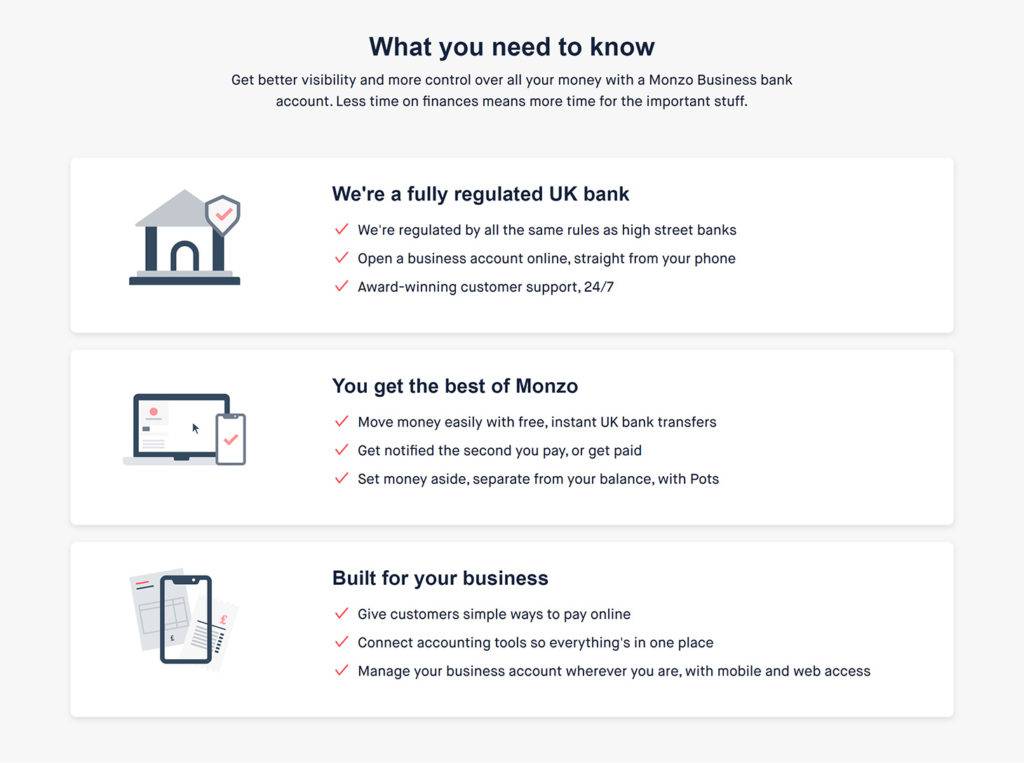
From nearly the very beginning of the page, I can read that they’re regulated by the same rules as other high street banks. This helps foster trust and credibility.
I can also identify key product features, such as instant UK bank transfers.
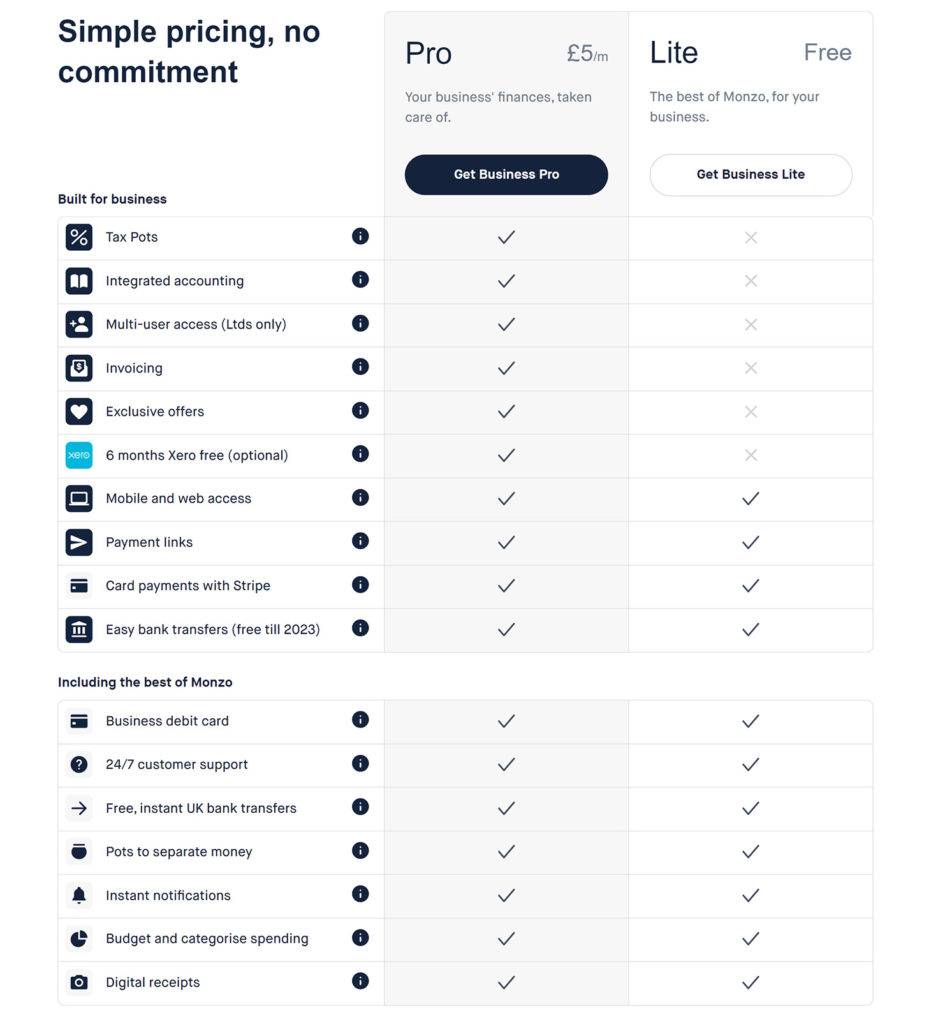
I can also learn more benefits and features of the product, with the associated price plans.
While Monzo’s product page can be improved, their content goes a long way in helping the page obtain that ‘beneficial purpose’.
For instance, I know:
- They’re credible, as they’re regulated
- A range of benefits and features, such as instant payment processing and 24/7 customer support
- The business account is easy to manage and is accessible. I can manage online or on the go through my mobile
When it comes to more blog type content, Google has a handy checklist of content quality items that you should be benchmarking against, in their broad core updates blog.
Are customer service options available, comprehensive and easy to follow?
If your business is in the financial services industry, then you really need to provide a ‘frictionless’ means for customers to engage with and understand your customer service options.
Think about it, if you’re letting an entity handle your money, then you want to be assured that you can contact someone or follow help and guidance steps should the need arise.
And Google agrees. They stress the importance of websites that handle money having contact details.
“Contact information and customer service information are extremely important for websites that handle money, such as stores, banks, credit card companies, etc”
Source: section 2.5.3 of SQRGs, Finding About Us, Contact Information, and Customer Service Information
Lloyds Bank is a great example of a financial organisation that makes customer service a breeze.
As soon as you land on their site, it’s easy to spot and navigate to the different help and support options available.
There’s even a ‘Help & Support’ option with a question mark icon staring you in the face as part of their navigation.
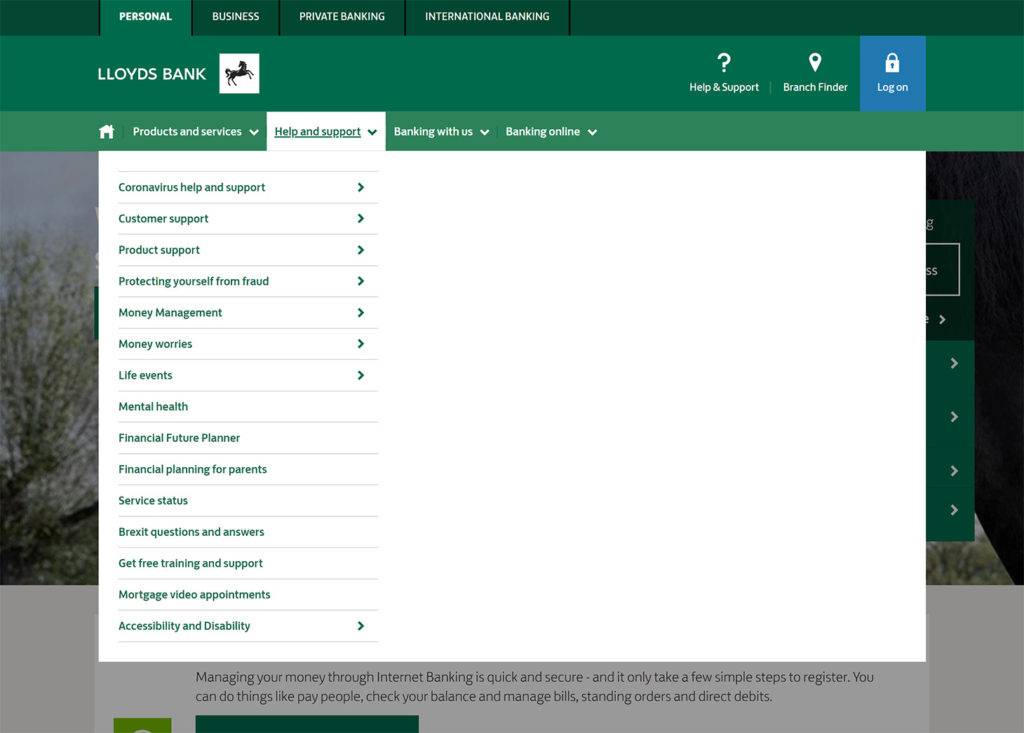
When you click ‘Help & Support’, the options include anything from reporting a lost and stolen card to even being able to call them directly.
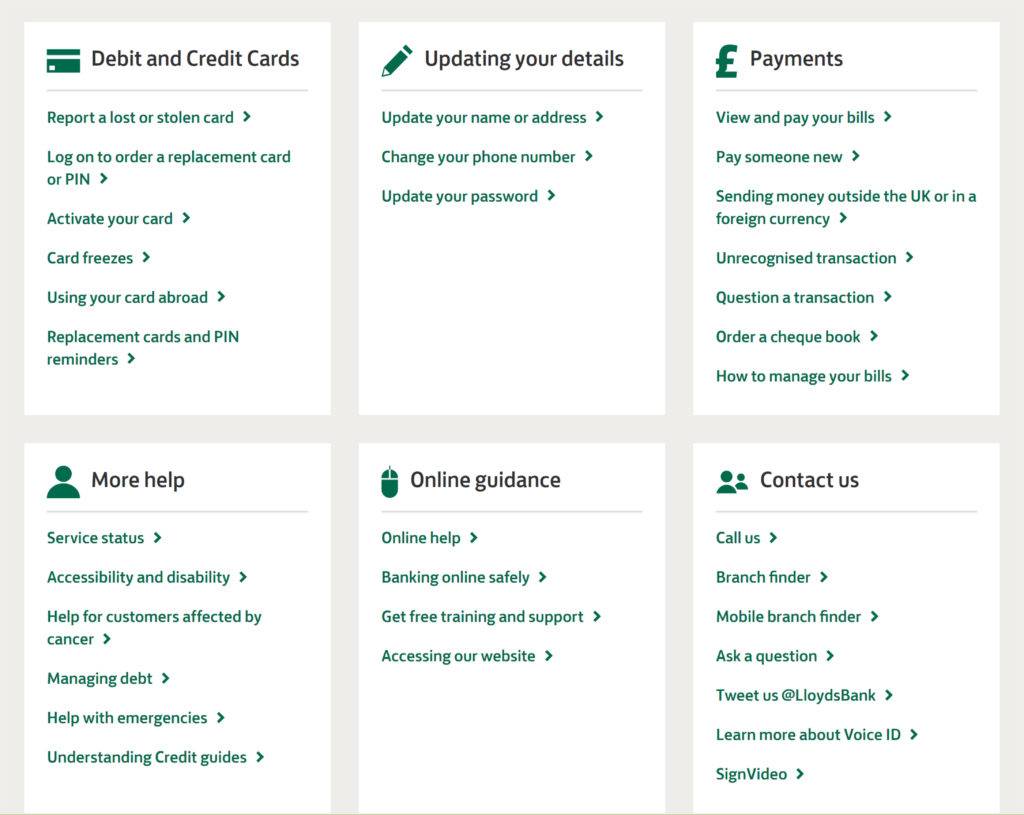
And if I click the ‘Report a lost or stolen card’ option, I’m given all the information I need, the different options I can pursue, including logging on online or calling customer service directly to report my lost or stolen card.
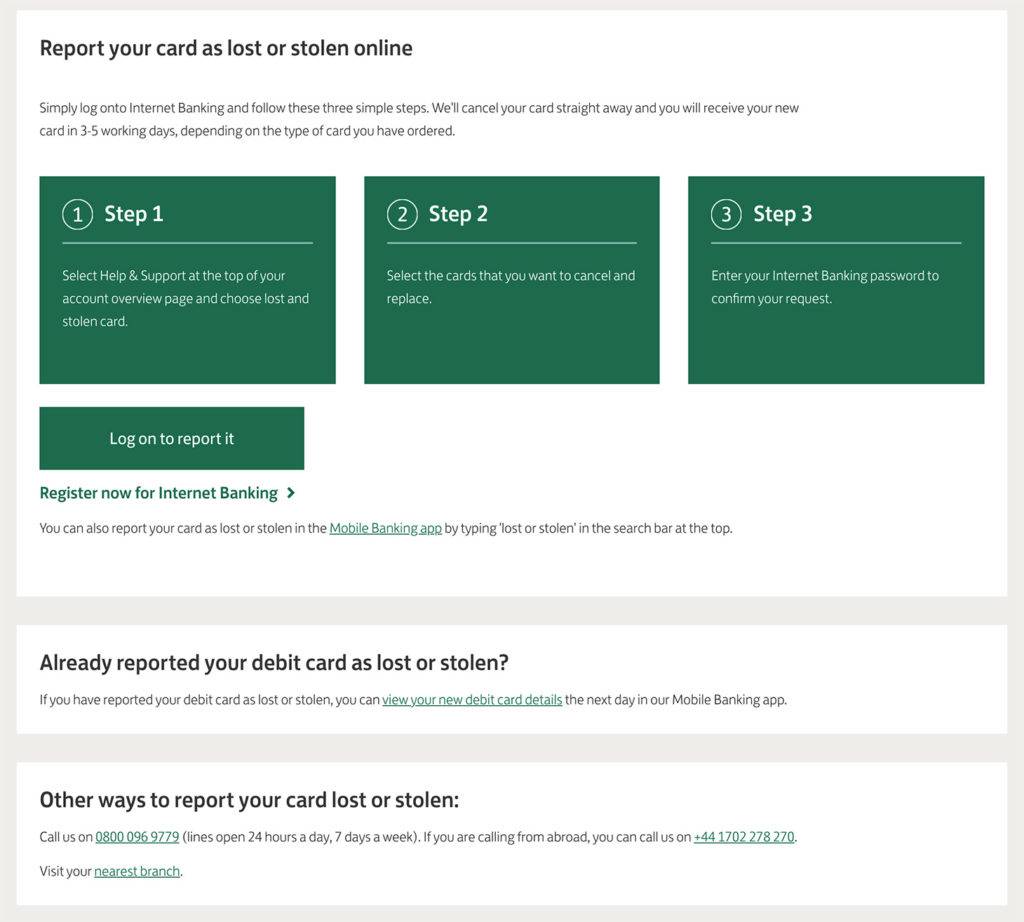
Talk about fostering trust and credibility!
Are the content creators and / or website an authoritative source on the topic they write about?
This is a must for any financial services brand.
The people (or entity) creating content needs to be relevant, trustworthy and credible. In other words, demonstrating E-A-T.
“Low quality pages often lack an appropriate level of E-A-T for the purpose of the page. Here are some examples:
The creator of the MC does not have adequate expertise in the topic of the MC, e.g. a tax form instruction video made by someone with no clear expertise in tax preparation.
The website is not an authoritative source for the topic of the page, e.g. tax information on a cooking website”
Source: section 6.1 of SQRGs, Lacking Expertise, Authoritativeness, or Trustworthiness (E-A-T)
Google actually boils down the points you want to consider to measure expertise, in their broad core updates blog.
The points focus on understanding whether the content creators and / or site are trustworthy and credible, with actual evidence to back that up.
The questions you need to think about are:
- How can you help identify if your content creators and / or site have an adequate level of expertise?
- What can you do to help create expertise on your site?
Audit the external reputation of your content creators and / or site
Google emphasises the importance of what experts in the field have to say for YMYL topics.
“For YMYL informational topics, the reputation of a website or content creator should be judged by what experts in the field have to say. Recommendations from expert sources, such as professional societies, are strong evidence of a very positive reputation”
Source: section 2.6.1 of SQRGs, Research on the Reputation of the Website and Creator of the Main Content
Google then gives sources of external reputation to use.
“News articles, Wikipedia articles, blog posts, magazine articles, forum discussions, and ratings from independent organizations can all be sources of reputation information. Look for independent, credible sources of information.”
Source: section 2.6.2 of SQRGs, Sources of Reputation Information
Google’s own example references Wikipedia as a source to help assess the external reputation of Annual Credit Report, which provides free credit reports for US citizens.
Notably, Google specifically highlights text in the Wikipedia article that is evidence of positive reputation information.

Now, you have to wonder if some of the unknown signals Google uses to measure E-A-T will take into account information found on reputable sources like Wikipedia.
Given Google uses Wikipedia for their Knowledge Graph (more on this later), you have to suspect so.
For individual authors, Google states biographical informational articles can be a good source of reputation information, which nicely leads us on to the next section.
Create author biography pages
While there’s little to no evidence to suggest author biography pages will directly help Google understand the E-A-T of content (although they have formed a part of winning strategies in our experience), they can certainly foster trust with users, as referenced in Google’s guide on measuring expertise. And this could improve conversion and the chance of winning a link.
As an example, let’s say I’m looking for information on ‘equity release’ and land on MoneySavingExperts page.
Before engaging with the content, I want to know who the creator of the content is. I see that it’s Martin Lewis and I can actually click through to his biography page and it’s one hell of a biography page.
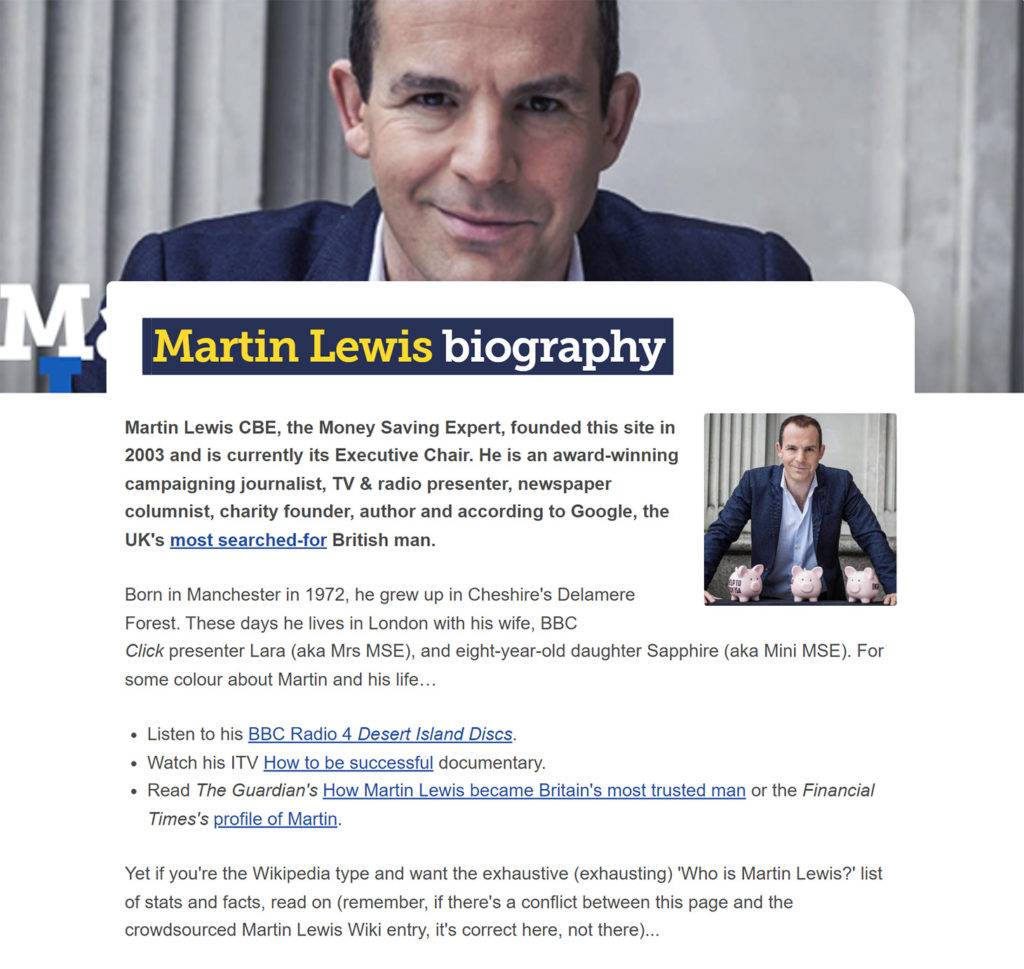
You have links to external sources of reputation information, which Google considers more important than internal sources of reputation management (more on this in the next section), his education and more information that illustrates his expertise.
Martin Lewis is an extreme example, but when creating author biography pages for finance content, think of including:
- Job title
- Years of experience, including any notable achievements and relevant specialisms
- Credible external publications they’ve been featured on
- Qualifications
- Link to social profiles if applicable
- Contact details
If the creator of content is the organisation itself, as opposed to an individual, then ensuring accreditations and other sources of expertise are easily found on the site.
Are you auditing what people think of your brand?
While Google claims sentiment is not used as part of their ranking algorithms (although we know this is different for reviews on Google My Business), negative sentiment can certainly hurt your brand.
To get a top-level overview of what people think of your brand, all you need to do is a bit of Googling using a search operator.
One of the handy search operators to use is:
- BRAND reviews -site:DOMAIN.com
All you have to do is swap ‘BRAND’ and the ‘DOMAIN’ with the site you want to research.
For example, let’s say I want to see online reviews for American Express. My search operator would look like the below:
- american express reviews -site:americanexpress.com
We’re telling Google to return reviews for American Express, that exclude pages on americanexpress.com.
And here’s what gets returned:
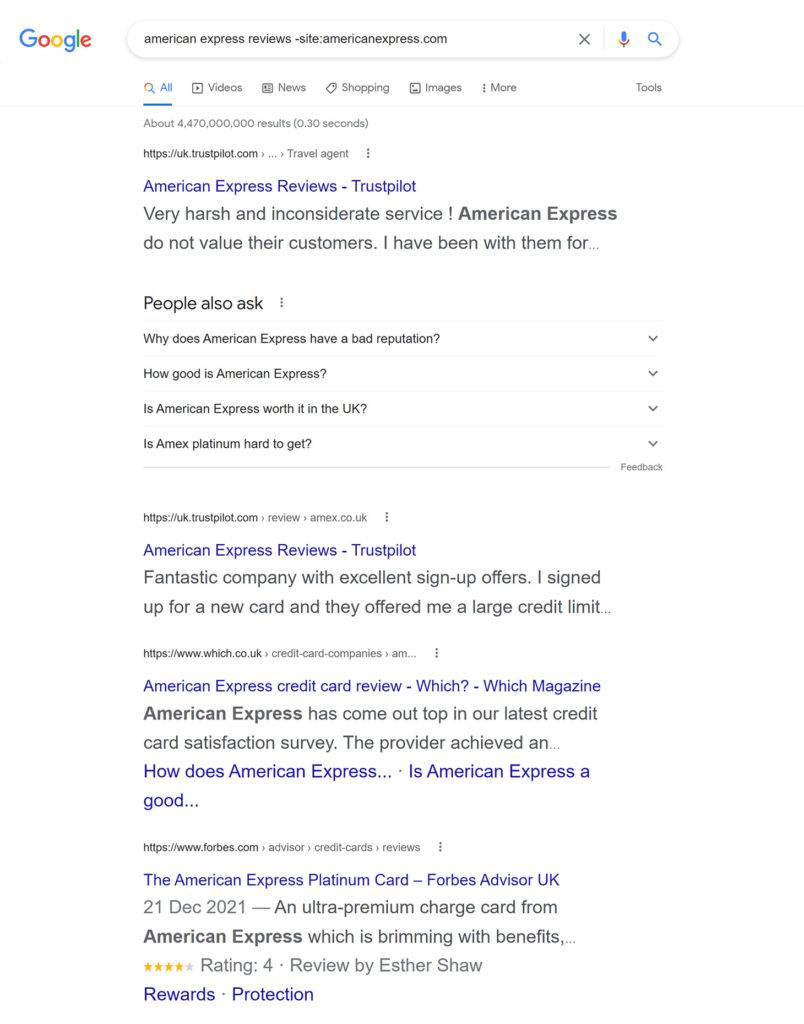
As you can see, this is a great starting point. In fact, it’s one of the instructions Google gives to Quality Raters when they’re asked to perform online reputation research.
And we can see the initial results for American Express don’t look too pretty.
Looking at Trustpilot reviews alone, there’s a common theme around poor customer service and experience:
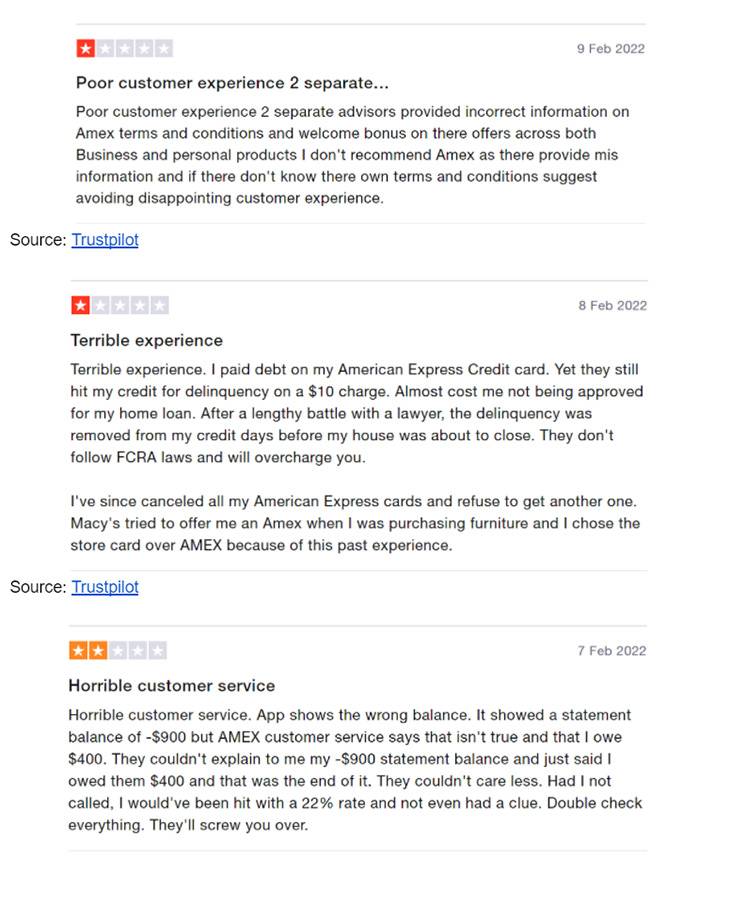
Source: https://uk.trustpilot.com/review/www.americanexpress.com
These types of reviews will be directly hurting American Express.
From an SEO perspective, it could certainly cause an indirect impact.
Think about it this way, would you be more or less likely to click on an American Express page in search results, having come across these negative reviews?
Review sites can also be a touchpoint before a branded search occurs.
Ironically, people complaining about customer service on Trustpilot and then American Express demonstrating a lack of customer service by not responding, will only further compound the downstream impact on clicks and conversions.
Ultimately, gaining good reviews and addressing the negative ones, showcases that you value your customers.
And after conducting a quick review of American Express, it looks like they have some work to do!
Are you using the Knowledge Graph to help Google understand that you’re an expert?
The Knowledge Graph allows Google to better understand how entities (a thing, place, or person) relate to a topic.
Essentially, Google uses information from a variety of sources, such as Wikipedia, Wikidata, CIA World Factbook and more as a means to make connections between an entity and a topic.
You can also add schema markup to connect your entity to these sources of information, making it all the more easier for Google to better understand that you have good standards of E-A-T.
Firstly, as a starting point, you can actually use a Knowledge Graph tool that will tell you how well Google understands your site or content creators.
For instance, if we add ‘martin lewis’ into the Knowledge Graph tool, we can see that Google understands Martin Lewis is a ‘Person’ who is a journalist.
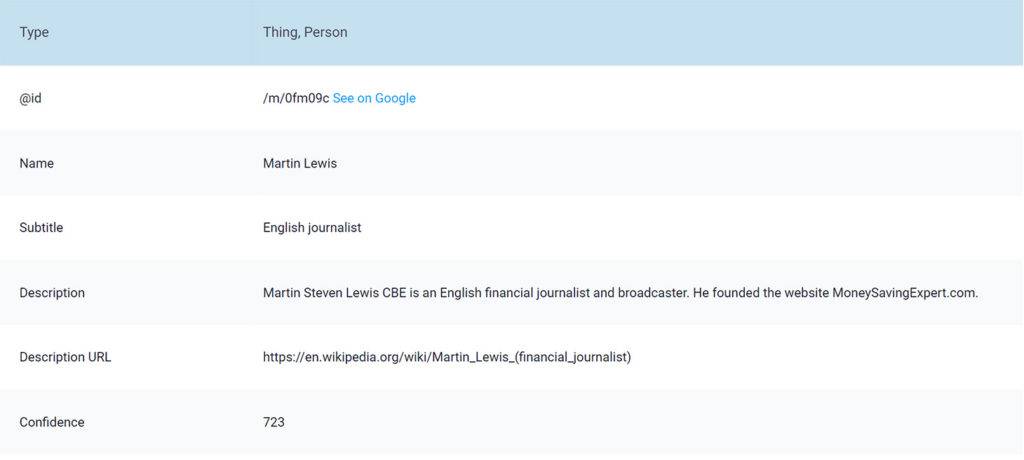
Google also connects that the Martin Lewis we searched for, is the same Martin Lewis in the Wikipedia article they reference in the ‘Description URL’ field and the Wikipedia article itself is a rich source of potential E-A-T signals.
Overall, this tool gives us a good indication that Google understands what and who Martin Lewis is as an entity and that he’s a credible source for finance topics.
It won’t be possible for every financial content creator / site to have a Wikipedia page, but implementing schema markup should be possible for everyone.
Consider the below schema markup properties to help Google better understand who you are as an entity and your E-A-T:
- Organisation schema markup on your homepage to give more information about your business. Make sure you integrate the sameAs property to link to trusted third party sources like a Wikipedia page if you have one.
- Person schema markup on author biography pages to give more information about your authors.
- Article schema markup on your blog and article pages to make it easy for Google to pinpoint the content you produce. You can integrate the author property and either add the ‘Organisation’ if an individual author isn’t producing the content or an actual ‘Person’.
- Citations schema markup to reference external sources of your work, such as articles on reputable third party websites.
Conclusion
To wrap up this guide, I’m going to summarise the key points you should consider:
Are you fulfilling the objective of the page?
Look at each different page type you have on your site, such as a product page or a blog page and really think about whether you’re satisfying the objective of the page.
Are they helpful to users? Do your pages contain the key information that your users need or will they have to go elsewhere?
Are customer service options available, comprehensive and easy to follow?
Can users easily find customer service options on your site? Are the instructions easy to understand and follow?
Are the content creators and / or website an authoritative source on the topic they write about?
Can users find credible external sources of reputation management information, such as a Wikipedia page, news articles, forum discussions and more?
Can users easily find information on your site that illustrates expertise, such as an author biography page that links out to credible third party sources?
Are you auditing what people think of your brand?
Are there lots of negative reviews for your brand? If so, are you tackling them?
Are you using the Knowledge Graph to help Google understand that you’re an expert?
Does your organisation and / or content creators have a dedicated Wikipedia page? Are you listed in financial services governing bodies, such as UK Finance?
Are you adding schema markup to help Google better understand who you are as an entity and your E-A-T?
Importantly, beyond SEO, demonstrating your E-A-T will lead to other benefits, such as improved brand recall and awareness.
Additionally, while we’ve covered loads of ways to improve the user experiences and perceived E-A-T of your site, check out our off-page for financial services guide to help build links, which are a key signal Google uses when understanding the E-A-T of a site.
If you’d like to talk to Builtvisible about any aspect of its work on E-A-T, get in touch via our contact form and we’ll get back to you for an exploratory discussion.
Further reading
- builtvisible.com/seo-financial-services-technical-issues-to-boost-your-website/
- builtvisible.com/seo-strategy-diversify-from-paid-media/
- builtvisible.com/seo-for-financial-services-off-page-seo/
- builtvisible.com/seo-financial-services-on-page-content/
- builtvisible.com/seo-for-financial-services-developing-a-winning-strategy/
- builtvisible.com/how-ymyl-websites-can-improve-e-a-t/
- builtvisible.com/digital-pr-trends-for-financial-services-brands/
- builtvisible.com/7-ways-to-maximise-your-existing-content/
- builtvisible.com/why-creating-complete-content-helps-you-rank/
